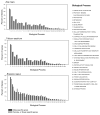Gender-specific selection on codon usage in plant genomes
- PMID: 17567911
- PMCID: PMC1919372
- DOI: 10.1186/1471-2164-8-169
Gender-specific selection on codon usage in plant genomes
Abstract
Background: Currently, there is little data available regarding the role of gender-specific gene expression on synonymous codon usage (translational selection) in most organisms, and particularly plants. Using gender-specific EST libraries (with > 4000 ESTs) from Zea mays and Triticum aestivum, we assessed whether gender-specific gene expression per se and gender-specific gene expression level are associated with selection on codon usage.
Results: We found clear evidence of a greater bias in codon usage for genes expressed in female than in male organs and gametes, based on the variation in GC content at third codon positions and the frequency of species-preferred codons. This finding holds true for both highly and for lowly expressed genes. In addition, we found that highly expressed genes have greater codon bias than lowly expressed genes for both female- and male-specific genes. Moreover, in both species, genes with female-specific expression show a greater usage of species-specific preferred codons for each of the 18 amino acids having synonymous codons. A supplemental analysis of Brassica napus suggests that bias in codon usage could also be higher in genes expressed in male gametophytic tissues than in heterogeneous (flower) tissues.
Conclusion: This study reports gender-specific bias in codon usage in plants. The findings reported here, based on the analysis of 1,497,876 codons, are not caused either by differences in the biological functions of the genes or by differences in protein lengths, nor are they likely attributable to mutational bias. The data are best explained by gender-specific translational selection. Plausible explanations for these findings and the relevance to these and other organisms are discussed.
Figures



Similar articles
-
Molecular evolution of synonymous codon usage in Populus.BMC Evol Biol. 2008 Nov 4;8:307. doi: 10.1186/1471-2148-8-307. BMC Evol Biol. 2008. PMID: 18983655 Free PMC article.
-
Analysis of synonymous codon usage in Zea mays.Mol Biol Rep. 2010 Feb;37(2):677-84. doi: 10.1007/s11033-009-9521-7. Epub 2009 Mar 29. Mol Biol Rep. 2010. PMID: 19330534
-
Analysis of synonymous codon usage patterns in different plant mitochondrial genomes.Mol Biol Rep. 2009 Nov;36(8):2039-46. doi: 10.1007/s11033-008-9414-1. Epub 2008 Nov 14. Mol Biol Rep. 2009. PMID: 19005776
-
Codon usage bias.Mol Biol Rep. 2022 Jan;49(1):539-565. doi: 10.1007/s11033-021-06749-4. Epub 2021 Nov 25. Mol Biol Rep. 2022. PMID: 34822069 Free PMC article. Review.
-
[The analysis method and progress in the study of codon bias].Yi Chuan. 2007 Apr;29(4):420-6. doi: 10.1360/yc-007-0420. Yi Chuan. 2007. PMID: 17548303 Review. Chinese.
Cited by
-
Sex-linked transcriptional divergence in the hermaphrodite fungus Neurospora tetrasperma.Proc Biol Sci. 2013 Jun 19;280(1764):20130862. doi: 10.1098/rspb.2013.0862. Print 2013 Aug 7. Proc Biol Sci. 2013. PMID: 23782882 Free PMC article.
-
Differential evolutionary patterns and expression levels between sex-specific and somatic tissue-specific genes in peanut.Sci Rep. 2017 Aug 21;7(1):9016. doi: 10.1038/s41598-017-09905-8. Sci Rep. 2017. PMID: 28827710 Free PMC article.
-
Production of a Highly Protease-Resistant Fungal α-Galactosidase in Transgenic Maize Seeds for Simplified Feed Processing.PLoS One. 2015 Jun 8;10(6):e0129294. doi: 10.1371/journal.pone.0129294. eCollection 2015. PLoS One. 2015. PMID: 26053048 Free PMC article.
-
Adaptation of codon and amino acid use for translational functions in highly expressed cricket genes.BMC Genomics. 2021 Apr 6;22(1):234. doi: 10.1186/s12864-021-07411-w. BMC Genomics. 2021. PMID: 33823803 Free PMC article.
-
Virus-host coevolution: common patterns of nucleotide motif usage in Flaviviridae and their hosts.PLoS One. 2009 Jul 20;4(7):e6282. doi: 10.1371/journal.pone.0006282. PLoS One. 2009. PMID: 19617912 Free PMC article.
References
-
- Chiapello H, Lisacek F, Caboche M, Henaut A. Codon usage and gene function are related in sequences of Arabidopsis thaliana. Gene. 1998;209:GC1–GC38. - PubMed
Publication types
MeSH terms
Substances
LinkOut - more resources
Full Text Sources
Research Materials
Miscellaneous

